|
 Nederlands /
Dutch Nederlands /
Dutch
Other insects and springtails in the garden
Here a few interesting insects, which don't belong to the other
insects on this site and some springtails.
What is actually an insect? Hopefully this classification gives clarity.
Arthropods (Arthropoda) are divided into four classes: 1. Hexapods (Hexapoda) 2.
Arachnids (Arachnida) 3. Crustaceans (Crustacea) 4. Millipedes (Myriapoda).
Properties: External skeleton of chitin (exoskeleton). Segmented body and jointed limbs.
The external skeleton
does not grow, so larvae have to 'molt'.
1. Hexapoda (from the Greek for six legs) with insects as the largest group. Furthermore: springtails (Collembola),
two-pronged bristletails (Diplura) and proturans or coneheads (Protura), but these three groups were also sometimes assigned to the insects as a separate group Apterygota.
Insects consist of three parts (head, thorax, abdomen, abdomen is divided into segments). Six legs.
2. Arachnids (Arachnida). Their body is organized into the two parts
(called tagmata) the prosoma (or cephalothorax, the head and the thorax fused together) and the
abdomen. Eight legs.
3. Crustaceans (Crustacea) are made up of two parts the prosoma ( or
cephalothorax, the head and the thorax fused together) and the abdomen. (the
abdomen is divided into segments). Ten legs or more. Lobsters, crabs, woodlice belongs to this
class.
4. Millipedes or pinnipeds (Myriapoda). Their body is entirely organized of segments.
Each segment with a pair of legs.
Insects are further divided into 1. Exopterygota (Hemimetabola) (= The
larvae undergo a modest change between immature and adult, without going through a pupal stage.
Like from nymph to a true bug) and 2. Endopterygota (Holometabola) (= the
larvae undergo a complete metamorphosis with a pupal stage. Like from caterpillar to butterfly)
|
1. Exopterygota (Hemimetabola) including:
Ephemeroptera - Mayflies or Canadian soldiers, hadflies, fishflies
Plecoptera - Stoneflies
Odonata - Dragonflies
Orthoptera - Grasshoppers and crickets
Phasmatodea - Stick insects or stick-bugs, walking sticks
Dermaptera - Earwigs
Blattaria - Cockroaches
Isoptera - Termites
Psocoptera - Booklice or barklice, barkflies
Thysanoptera - Thrips
Hemiptera - True bugs, aphids and cicadas
|
|
2. Endopterygota (Holometabola) including:
Neuroptera - Net-winged insects
Raphidioptera - Snakeflies
Megaloptera - Alderflies
Mecoptera - Mecopterans or scorpionflies
Trichoptera - Caddisflies
Lepidoptera - Butterflies
Diptera - flies and gnats
Siphonaptera - Fleas (are secondary non-winged)
Coleoptera - Beetles
Hymenoptera - Bees, bumblebees, wasps and ants |
Grasshoppers
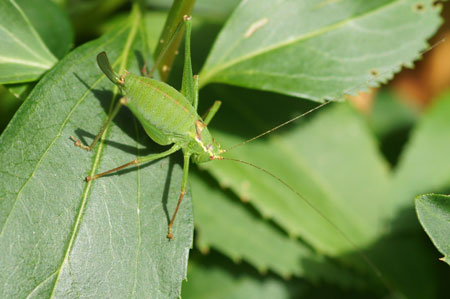 .. ..
 Female.
Speckled bush-criket (Leptophyes punctatissima). Subfamily Phaneropterinae.
Family bush-criket (Tettigoniidae). Photos August 2010. Female.
Speckled bush-criket (Leptophyes punctatissima). Subfamily Phaneropterinae.
Family bush-criket (Tettigoniidae). Photos August 2010.
As you can see in the pictures, there is a clear difference between males and females of this light green grasshopper. The small ovipositor of the females curves upwards. The forewings are too small to fly.
Similar species are Barbitistes serricauda (larger) and the leptophyes albovittata (white stripes along the flanks). The sound they make is too high for human ears.
Males 10-13 mm, females 13-18 mm. Across most of Europe. June-October. |
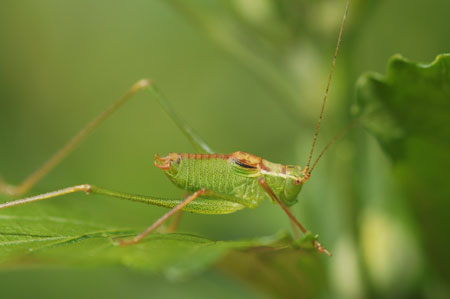 ,, ,,  Male.
Speckled bush-criket (Leptophyes punctatissima). Subfamily Phaneropterinae.
Family bush-criket
(Tettigoniidae). Photos August 2010. Male.
Speckled bush-criket (Leptophyes punctatissima). Subfamily Phaneropterinae.
Family bush-criket
(Tettigoniidae). Photos August 2010. |
 Photo1-6-2013. The nymphs of the Speckled bush-crikets are speckled black and have black bands on the antennae and legs.
Photo1-6-2013. The nymphs of the Speckled bush-crikets are speckled black and have black bands on the antennae and legs. |
 Southern oak bush cricket (Meconema meridionale). Subfamily Meconematinae. Family bush-criket (Tettigoniidae). Southern oak bush cricket (Meconema meridionale). Subfamily Meconematinae. Family bush-criket (Tettigoniidae).
A light green grasshopper with a clear light yellow stripe from head to the backside of the body. The wings are very small. They don't fly. and don't jump. The male has a thread-like cerci. The female has a fairly long sword-shaped ovipositor.
It is a southern European species., most probably together with garden plants in the Netherlands ended. They can also tails with holidaymakers. Maybe Cheilosia caerulescens is spread by the sale of southern European garden plants. Or in the luggage of holidaymakers. It feeds on small insects like aphids. Males 11-13 mm, females 11-16 mm. August - November. Photo female 17-10-2010. |
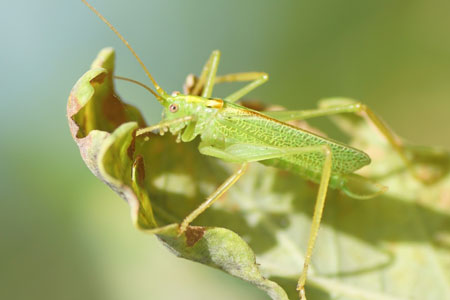 .. ..
 Oak bush-cricket, drumming katydid (Meconema thalassinum). Subfamily Tettigoniinae. Meconematinae. Family bush-criket (Tettigoniidae).
Oak bush-cricket, drumming katydid (Meconema thalassinum). Subfamily Tettigoniinae. Meconematinae. Family bush-criket (Tettigoniidae).
A light green grasshopper with a clear light yellow stripe across the body. Gauze-shaped wings vein patterns of the wings. Tthey can fly well.
It has a preference for oak. It feeds on small bugs like aphids. Length 12-15 mm. July-November. Europe, Introduced in America.Photos 7-8-2018.
|
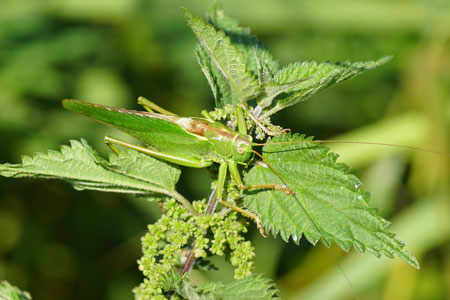 Great green bush-cricket (Tettigonia viridissima). Subfamily Tettigoniinae.
Family bush-criket
(Tettigoniidae). About 500 meter from our house.
Great green bush-cricket (Tettigonia viridissima). Subfamily Tettigoniinae.
Family bush-criket
(Tettigoniidae). About 500 meter from our house.
Large, but difficult to find because of the green color. Male 28-34 millimeters, female 27-38 mm. Lives on insects. March-October. Europe, Asia. Photo 5-9-2021.
 16-9-2021 The same month I also saw a Tettigonia viridissima in our garden. An impressive
bush-cricket..
16-9-2021 The same month I also saw a Tettigonia viridissima in our garden. An impressive
bush-cricket..
|
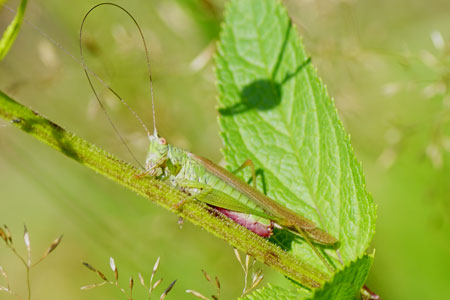 Long-winged conehead (Conocephalus fuscus). Subfamily Conocephalinae. Family bush-criket
(Tettigoniidae).
Long-winged conehead (Conocephalus fuscus). Subfamily Conocephalinae. Family bush-criket
(Tettigoniidae).
A light green grasshopper. Long wings, brown on top. Long antennae. Resembles the short-winged conehead (Conocephalus dorsalis), which usually has shorter wings.
It feeds on herbs and grasses, and small insects like aphids. Length 12-18 mm. July-October. Native to southern, central, and eastern Europe, but has now spread throughout the Netherlands. First seen in our garden in 2025.
Photo 25-7-2025. |
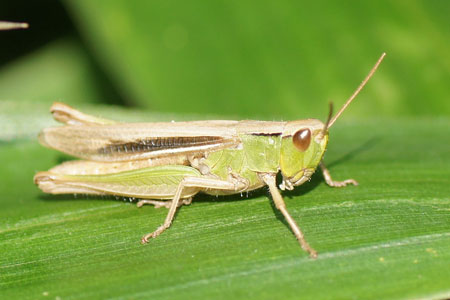 .. ..
 Lesser Marsh Grasshopper (Chorthippus albomarginatus). Family Acrididae.
Lesser Marsh Grasshopper (Chorthippus albomarginatus). Family Acrididae.
The "pronotal side-keels" and the bars of the Lesser Marsh Grasshopper are approximately parallel. It has long wings totally pale legs. The colour is variable from green to brown. It looks like the C. montanus and the Meadow grasshopper (C. parallelus), but these grasshoppers have a dark hind knee and usually shorter wings. The C. dorsatus is also similar, but is very rare in the Netherlands.) Length 13-23 mm. June-September. Photos 9-8-2013.
|
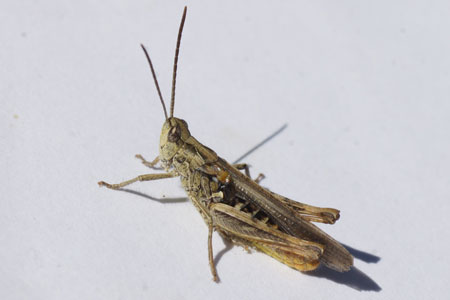 .. ..
 . .
 Common Field Grasshopper (Chorthippus brunneus). Family Acrididae.
Common Field Grasshopper (Chorthippus brunneus). Family Acrididae.
The common field grasshopper is brown in colour. The pronotum is paler.
The three species common field grasshopper, bow-winged grasshopper (Chorthippus biguttulus) and Chorthippus mollis are very similar to each other. The males are easy to identify by sound. The females of the threes species are very difficult to identify.
Europe. In the Netherlands, a very common grasshopper. Length males from 12-17 mm and females 18-25 mm.May-September. Photos 20-7-2014. 9-7-2017
German: Verkannter Grashüpfer. French: Criquet duettiste.
|
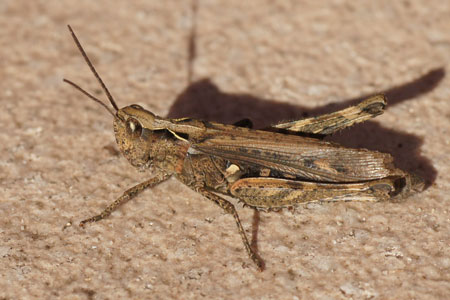 .. ..
 Chorthippus
biguttulus-group. Female. Family Acrididae. Chorthippus
biguttulus-group. Female. Family Acrididae.
This is the female sitting on the terrace and which can not be determined.
So: Common field grasshopper (Chorthippus brunneus), bow-winged grasshopper (Chorthippus biguttulus) and Chorthippus mollis. Photos 11-9-2015. |
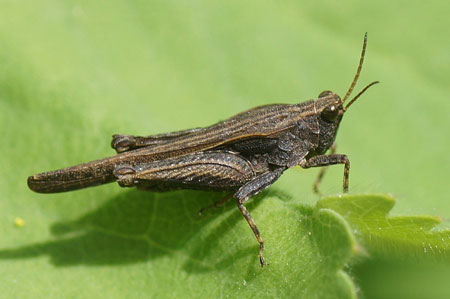 Slender Ground-hopper, slender Grouse Locust (Tetrix subulata). Subfamily Tetriginae. Family groundhoppers, pygmy grasshoppers (Tetrigidae). Slender Ground-hopper, slender Grouse Locust (Tetrix subulata). Subfamily Tetriginae. Family groundhoppers, pygmy grasshoppers (Tetrigidae).
In 2015,for the first time in our garden. The slender ground-hopper mainly feed on algae, mosses and lichens, but also on grasses. They have a preference for humid areas.
Length: about 10-15 mm. March - September Europe, North Africa. Photo 9-5-2015.
German: Säbel-Dornschrecke. French: Le Tétrix riverain. |
Grasshoppers photographed in the dunes.
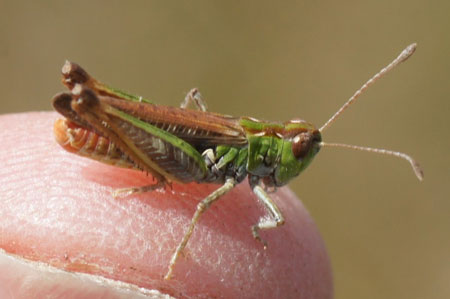 Mottled Grasshopper (Myrmeleotettix maculatus). Subfamily Gomphocerinae. Family Acrididae. Mottled Grasshopper (Myrmeleotettix maculatus). Subfamily Gomphocerinae. Family Acrididae.
The motted grasshopper is variable in colour. From brown to green. They are recognizable at the thickened ends of the antennae. That's very visible to the male. To the female less. These ends are more flattened than widened.
Especially on dry heath fields and dotted sand dunes. In the eastern part of the Netherlands and in the dunes. June - September. Length 10-16 mm. Photo 18-7-2017.
German: Gefleckte Keulenschrecke. French: Le Gomphocère tacheté. |
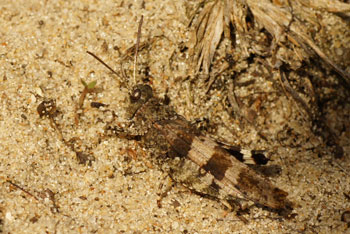 Blue-winged grasshopper (Oedipoda caerulescens). Subfamily Oedipodinae. Family Acrididae. Blue-winged grasshopper (Oedipoda caerulescens). Subfamily Oedipodinae. Family Acrididae.
A brown grasshopper with pale brown spots. Mostly with pale and dark bands around the legs. It is well camouflaged. Very characteristic is the blue turquoise colour of the hind wings, but this is only visible in flight. At rest, it looks like the red-winged grasshopper (Oedipoda germanica), which of course has red wings. He eats mainly grass.
In the Netherlands, in sandy areas, such as the dunes. Abroad also in other areas such as limestone soils, gravel plains. Never bushy places. The body coloration of the grasshoppers in these areas varies depending on the substrate on which the animals have developed. June - October Length females 20-29 mm, males 13-23 mm. Photo 10-10-2014. |
 Cepero's groundhopper
(Tetrix ceperoi). Subfamily Tetriginae. Family groundhoppers, pygmy grasshoppers (Tetrigidae). Cepero's groundhopper
(Tetrix ceperoi). Subfamily Tetriginae. Family groundhoppers, pygmy grasshoppers (Tetrigidae).
The Cepero's groundhopper is variable in colour. From brown to green. It looks like the species of the Slender Groundhopper (Tetrix subulata). However, the antennas are closer together.
Especially in humid sandy soils with clearings, where it feeds on algae. March - September Length females 11-13 mm, males from 9.5 to 10.5 mm. Photo 10-3-2014. |
Familiy Limnephilidae, Leptoceridae, Phryganeidae, Polycentropodidae. Order Caddisflies
(Trichoptera).
In
the Netherlands are 177
species. The larvae prevent in the water and build a cocoon using materials such as silk, silt, small fragments of rock, sand, small pieces of
twig, aquatic plants. I see them oft
in the pond.
Each species has its own kind of cocoon. When the Caddisfly is ready to go into metamorphosis,
it will seal itself inside it's cocoon. It emerges in four weeks as a
pre-adult. Then it will swim out of the water and shed one more skin
before it's wings will be fully formed, and it's able to fly away.
Most adults are non-feeding. The female caddisfly
will often lay eggs (enclosed in a gelatinous mass) by attaching them to
the plants of the pond above or below the water surface.
Most species have long antennae.
 Cocoon of a Caddisfly, Trichoptera. In our pond. Photo 10-6-2012.
Cocoon of a Caddisfly, Trichoptera. In our pond. Photo 10-6-2012. |
 Mystacides
longicornis. Subfamily Leptocerinae. Familiy Leptoceridae. Order Caddisflies (Trichoptera). Mystacides
longicornis. Subfamily Leptocerinae. Familiy Leptoceridae. Order Caddisflies (Trichoptera).
The wings are yellowish brown with three dark brown cross bands. The antennas are long. The male has large palps. The larvae live in the water of plant material and sometimes small water animals. The larva overwinters. The case is covered with sand grains. Length to 9 mm. Palearctic. Photo 4-8-2018. |
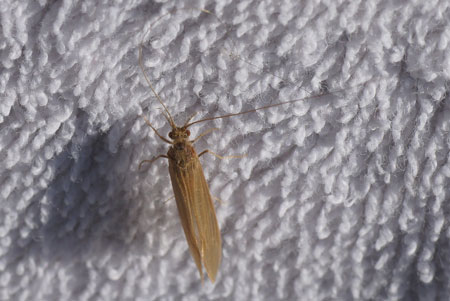 .. ..
 Mystacides
longicornis. Subfamily Leptocerinae. Familiy Leptoceridae. Order Caddisflies (Trichoptera). Mystacides
longicornis. Subfamily Leptocerinae. Familiy Leptoceridae. Order Caddisflies (Trichoptera).
The wings are yellowish brown with three dark brown cross bands. The antennas are long. The male has large palps.
The larvae live in the water of plant material and sometimes small water animals. The larva overwinters. The case is covered with sand grains. Length to 9 mm. Palearctic. Photo 4-8-2018. |
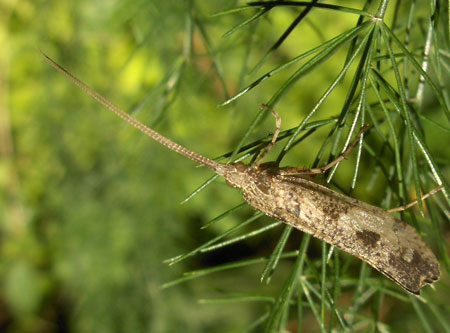 .. ..
 . .
 . .
 Glyphotaelius pellucidus. Familiy Limnephilidae. Order Caddisflies (Trichoptera). Glyphotaelius pellucidus. Familiy Limnephilidae. Order Caddisflies (Trichoptera).
This is a common species in Holland and is to recognize because of the notched outside edge of the marbled forewing. Length 12-17 mm. April - June and August - October Palearctic. Photos 28-08-2007. |
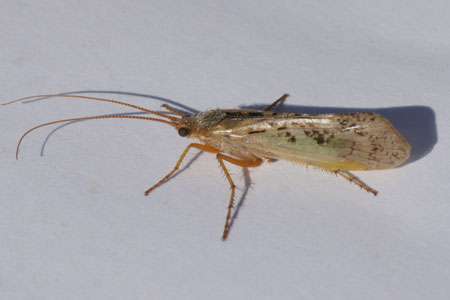 Limnephilus flavicornis. Familiy Limnephilidae. Order Caddisflies (Trichoptera).
Limnephilus flavicornis. Familiy Limnephilidae. Order Caddisflies (Trichoptera).
A tan Caddisfly. On the wings are pale gray-brown with darker spots. Length 11 - 17 mm. May - October. Photos 6-7-2015.
|
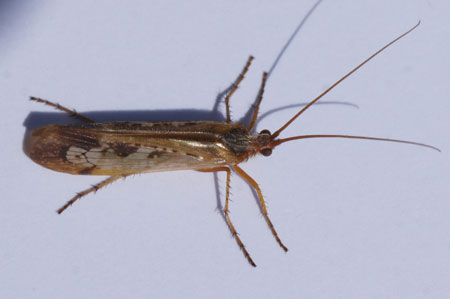 .. ..
 Limnephilus marmoratus. Familiy Limnephilidae. Order Caddisflies (Trichoptera).
Limnephilus marmoratus. Familiy Limnephilidae. Order Caddisflies (Trichoptera).
The wings are more strongly marked than the Limnephilus flavicornis. At night they are attracted to light. Length 12 - 17 mm. Photos 22-7-2015. |
 Agrypnia
pagetana. Family Phryganeidae. Order Caddisflies (Trichoptera). Agrypnia
pagetana. Family Phryganeidae. Order Caddisflies (Trichoptera).
A general uniform cream-colored shooting moth. Clear wing veins. At night they are attracted to light, but they also fly like here during the day. Light orange yellow solid antennas (compared to the family Leptoceridae ), which are about the same length as the body. It can be found early in the spring. Photo 11-5-2018. |
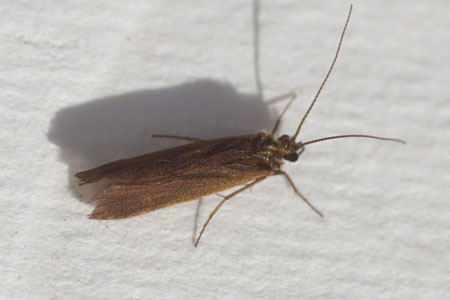 Holocentropus. Family Polycentropodidae. Order Caddisflies (Trichoptera).
Holocentropus. Family Polycentropodidae. Order Caddisflies (Trichoptera).
In the Netherlands four species: Holocentropus dubius, Holocentropus insignis (very rare), Holocentropus picicornis, Holocentropus stagnalis (rare). Pretty small caddisflies, with reasonably short antennae. Difficult to identify. This is the unspotted brown form 'aurata'. Length 6-9 mm. Photo 18-8-2018.
|
Caddisflies photographed in the dunes.
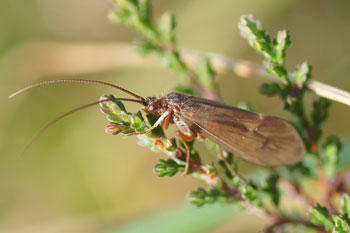 Anabolia nervosa. Familiy Limnephilidae. Order Caddisflies (Trichoptera). Anabolia nervosa. Familiy Limnephilidae. Order Caddisflies (Trichoptera).
Both the body and the wings of this caddisfly are pale brown. On the wings some pale small spots, but no distinctive markings.
The most species in September October They have a preference for sand. The larvae also use sand grains to build their cases. Small sticks are also attached to the cases. The larvae feed on algae and small insects. Length 11 - 15 mm. Photo 18-10-2013. |
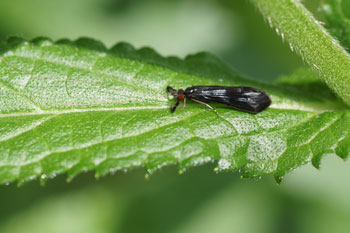 Mystacides
azureus. Subfamily Leptocerinae. Familiy Leptoceridae. Order Caddisflies (Trichoptera). Mystacides
azureus. Subfamily Leptocerinae. Familiy Leptoceridae. Order Caddisflies (Trichoptera).
The wings of this caddisfly are blue-black and it has red eyes. The antennae are very long and thin. Large palps.
The larvae live in the water of plant material and sometimes small water animals. The larva overwinters. Length 6-7 mm. Palearctic. May - October. Probably two generations. Photo 29-6-2013. |
Neuropterida.
Insects with transparent wings and clear, net-shaped wing veins. Often predatory larvae. Four wings instead of 2 wings as flies and mosquitoes.
In Neuropterida are the orders lacewings, antlions
(Neuroptera), alderflies, dobsonflies (Megaloptera) and snakeflies (Raphidioptera).
Family Lacewings - Chrysopidae, Hemerobiidae,
Coniopterygidae.
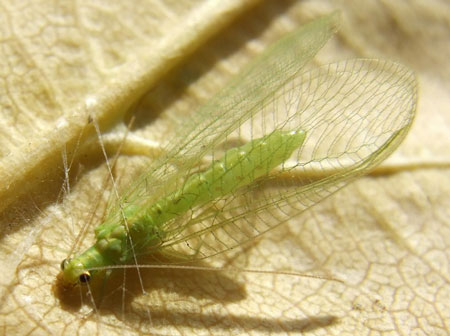 .. ..
 . .
 . .
 Green lacewing (Chrysoperla carnea). Family Chrysopidae. Order
Neuroptera.
Green lacewing (Chrysoperla carnea). Family Chrysopidae. Order
Neuroptera.
There are many species lacewings. Some species are very similar.
The four transparent wings are in rest folded like a little roof. It has large golden eyes. A general species in the Netherlands.
The eggs are laid at the tip of long stalks on the surface of leaves. The larvae feed on aphids, while adult animals also feed on nectar. It
fles at night.
In the greenhouses they are used against aphids. Larvae of some species are camouflaged with pieces of plants or dead aphids. Two generations in a year. The adult overwinters and turns in a brownish pink colour. The larva on this photo is perhaps of an other species. Length: 10 - 17 mm. German: Gemeine Florfliege oder Grüne Florfliege French: Chrysope verte |
 larva lacewing
larva lacewing  A camouflaged lacewing larva.
A camouflaged lacewing larva. |
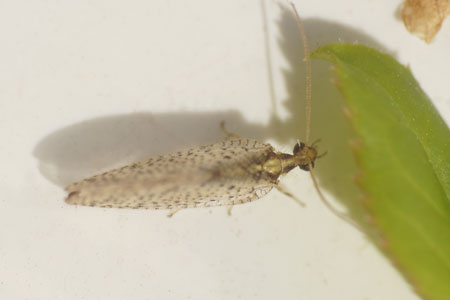 Hemerobius humulinus. Family brown lacewings (Hemerobiidae). Order
Neuroptera.
Hemerobius humulinus. Family brown lacewings (Hemerobiidae). Order
Neuroptera.
The brown lacewings (Hemerobiidae) look like the green lacewings (Chrysopidae). The colour is generally brown, they are smaller (exception is the Drepanepteryx
phalaenoides) and the wings have a different veins. In the Netherlands there are 29 species of brown lacewings. The larvae and adults mainly live on aphids.
Hemerobius humulinus is recognizable by the broad line on the thorax. Europe. Asia and North America. Photo 16-4-2019. |
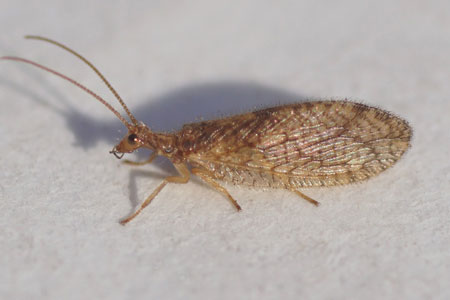 Micromus angulatus. Family brown lacewings (Hemerobiidae). Order Neuroptera.
Micromus angulatus. Family brown lacewings (Hemerobiidae). Order Neuroptera.
Recognizable by the shape of some darker veins. Europe. Africa and Asia, North America. Photo 18-6-2018. |
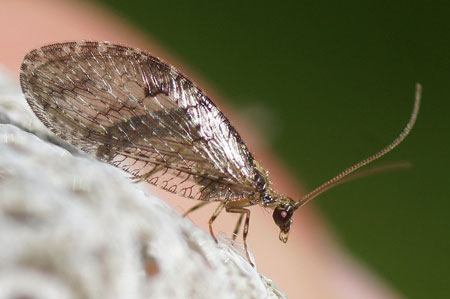 Wesmaelius spec. Family brown lacewings (Hemerobiidae). Order Neuroptera.
Wesmaelius spec. Family brown lacewings (Hemerobiidae). Order Neuroptera.
A small brown lacewing with striking wing pattern. There are some quite similar species. Photo 5-7-2014. |
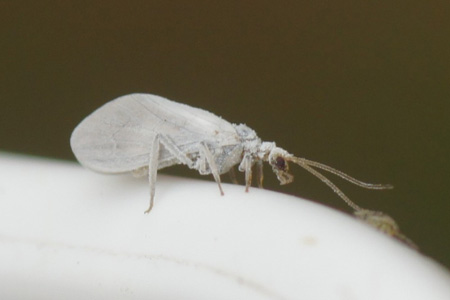 A dustywing from the family dustywings (Coniopterygidae). Order Neuroptera.
A dustywing from the family dustywings (Coniopterygidae). Order Neuroptera.
A small white gauze fly. There are fewer veins on the wings compared to other net-winged insects. They are covered with a whitish or gray powder was secreted by glands located in the head, chest and abdomen. The larvae and adult dwarf lacewings feed on small prey like aphids, scale insects and Acarina.
In the Netherlands there are five genera with twelve species. from a photo they are not to identify.
Photo 30-10-2016.
Genus Aleuropteryx: Aleuropteryx loewii.
Genus Coniopteryx C. borealis, C. esbenpeterseni, C. pygmaea, C. tineiformis, C. tjederi.
Genus Conwentzia C. pineticola, C.psociformis.
Genus Helicoconis: Helicoconis lutea.
Genus Parasemidalis: Parasemidalis fuscipennis.
Genus Semidalis S. aleyrodiformis, S. aleyrodiformis. |
 Larva dustywing
from the family dustywings (Coniopterygidae). Photo 17-10-2016 Larva dustywing
from the family dustywings (Coniopterygidae). Photo 17-10-2016 |
Family spongeflies or spongillaflies (Sisyridae).
A small family. The larvae feed on freshwater
sponges. In the Netherlands the species are: Sisyra dalii, Sisyra jutlandica, Sisyra
nigra, Sisyra terminalis. Sisyra nigra is the most common species.
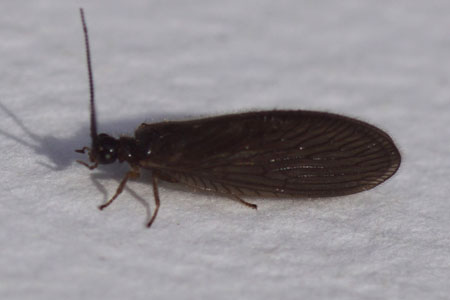 Sisyra nigra. Family spongeflies or spongillaflies (Sisyridae),. Orde netvleugeligen
(Neuroptera).
Sisyra nigra. Family spongeflies or spongillaflies (Sisyridae),. Orde netvleugeligen
(Neuroptera).
Very small and dark brown. Hairy wings with some cross veins and no forked veins along the front of the wing. Wingspan
is 10-12 mm. May September. In the Netherlands, the Sisyra nigra is the most common species, recognizable by the completely dark antennae. Europe, North Asia and North America. Photo 25-6-2019. |
Family alderflies (Sialidae).
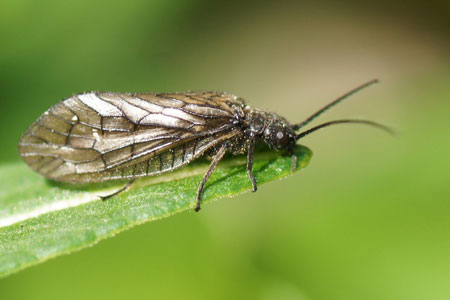 .. ..
 Alderfly
(Sialis cf. lutaria). Family alderflies (Sialidae). Order Megaloptera. Alderfly
(Sialis cf. lutaria). Family alderflies (Sialidae). Order Megaloptera.
A dark brown insect with large wings, which are folded at rest like a roof over the body. The veins in the wings are very clearly. Despite the name it isn't a fly. It has four wings.
cf means likely. Because from photos it is not to be distinguished from other species. This is the most common alder fly. The eggs are deposited on plants near the water. The larvae fall into the water. These aquatic predators live on the bottom and feed on for example insect larvae. Sialis lutaria is found in still or slow-flowing water. Sialis fuliginosais especially in fast-flowing water, Sialis nigripes near large rivers and Sialis flavilatera in muddy, stagnant water. In Europe, there are six known species. Length 35 mm. May - August. Photos 3-5-2013. |
Family Raphidiidae.
Snakeflies because of the resemblance to a snake. They mainly live in the
top of the trees. Females have a long ovipositor.
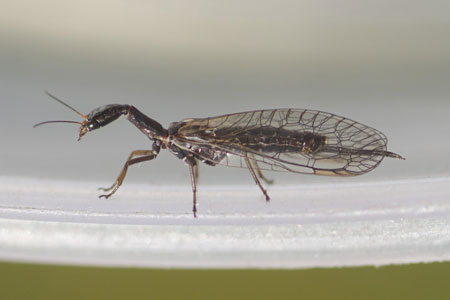 .. ..
 Xanthostigma
xanthostigma. Family Raphidiidae. Orde snakeflies (Raphidioptera). Xanthostigma
xanthostigma. Family Raphidiidae. Orde snakeflies (Raphidioptera).
IIn the Netherlands the six species are: Atlantoraphidia maculicollis, Inocellia crassicornis, Phaeostigma notata, Raphidia ophiopsis, Subilla confinis, Xanthostigma xanthostigma. Xanthostigma xanthostigma (backside of the head goes to the neck triangular) looks a lot like Subilla confinis (back of the head goes to the neck more trapezoidal). The shape of the head varies.
Sometimes it can be seen on tree trunks especially on oak.
The adult insects appear from the beginning of May. The larvae live on or under loose bark and feed on other insects. The adult insects are also predatory. Europe, Asia. Photos 23-4-2019. |
Family
Baetidae.
Mayflies have two or three tails at the end of the body. The nymphs
live about one year. The adults live much shorter.
Mayflies moult for the
last time, when they have wings already. The adults eat no more.
The nymphs of the different species of mayflies live in the water or in the boggy soil.
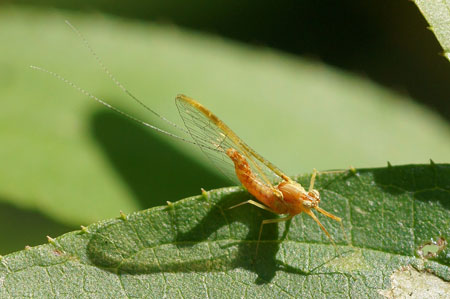 .. ..
 Mayfly, Cloeon dipterum. Family Baetidae. Mayfly, Cloeon dipterum. Family Baetidae.
Very common, often in ponds, where the larvae feed on algae.
Like other members of the genus Cloeon and Procloeon Cloeon dipterum has no rear wings (like other species), and two has two tails. The eyes of the males have an additional dorsal "turban-shaped" parts that function as superposition eyes. May - October. Palearctic and Nearctic.
Photo 1 female 4-7-2011, photo 2 male 3-7-2018. |
Scorpion fly (Panorpa).
Family scorpionflies (Panorpidae). Order Mecoptera.
All
species in the Netherlands.
In
2009 I have taken more photos. Arp Kruithof has determined these scorpion
flies. Thanks Arp.
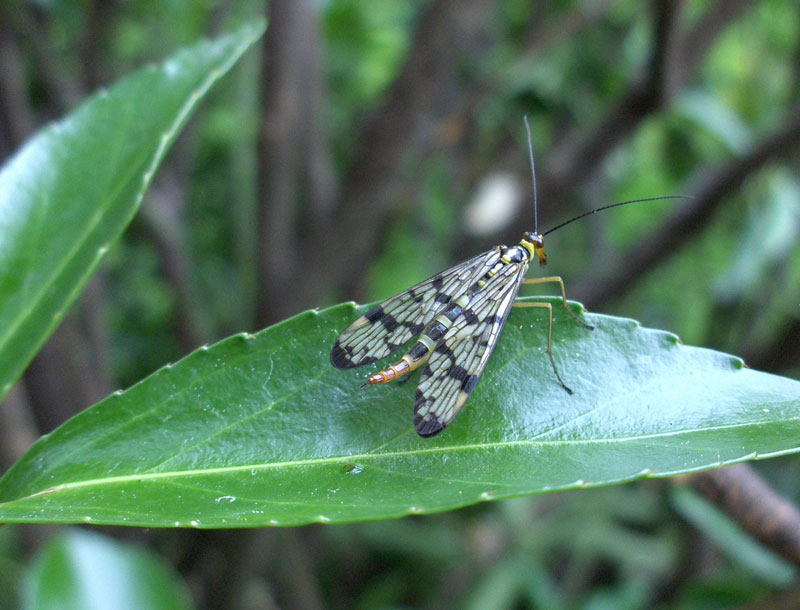 .. ..  . .
 Scorpion fly, Panorpa
germanica. Female. Family scorpion flies (Panorpidae). Photos 29-4-2009. Scorpion fly, Panorpa
germanica. Female. Family scorpion flies (Panorpidae). Photos 29-4-2009. |
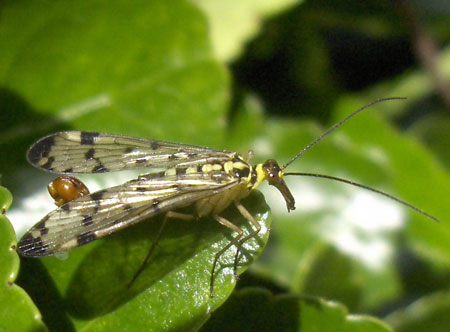 .. ..
 . .
 Scorpion fly, Panorpa germanica. Male. Family scorpion flies (Panorpidae). Photos 9-4-2009.
Scorpion fly, Panorpa germanica. Male. Family scorpion flies (Panorpidae). Photos 9-4-2009. |

 Photos 22-4-2009.
Photos 22-4-2009. |
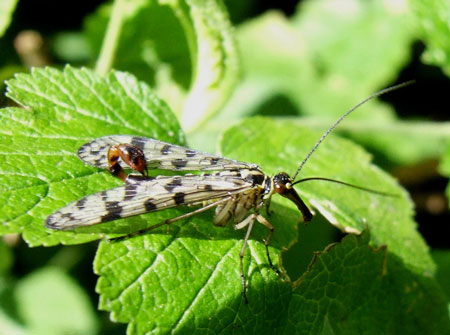 .. ..
 Scorpion fly, Panorpa
vulgaris. Male. Family scorpion flies (Panorpidae). Photos 13-6-2009. Scorpion fly, Panorpa
vulgaris. Male. Family scorpion flies (Panorpidae). Photos 13-6-2009. |
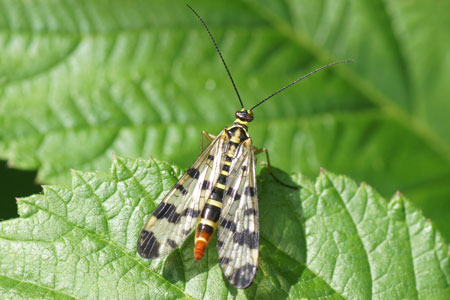 Scorpion fly, Panorpa
vulgaris. Female. Family scorpion flies (Panorpidae).
Scorpion fly, Panorpa
vulgaris. Female. Family scorpion flies (Panorpidae).
Female photograped in June 15, 2016. |
Lepismatidae.
Primitive wingless insects. Usually in warm humid environment and they avoid light. There are only a few types in the Netherlands. See the Dutch Waarneming.
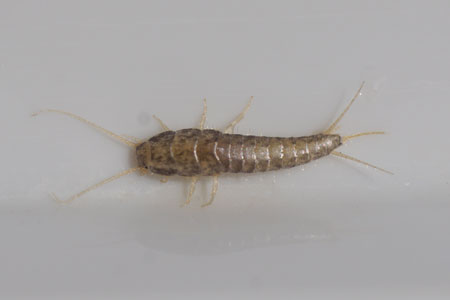 Gray silverfish, long-tailed silverfish or paper silverfish ( Ctenolepisma longicaudata)
Family Lepismatidae.
Gray silverfish, long-tailed silverfish or paper silverfish ( Ctenolepisma longicaudata)
Family Lepismatidae.
Thanks to Peter Boer for the identification. I myself thought of the similar Silverfish (Lepisma saccharina). Which has a shorter
tail. .An elongated, silver-colored insect. As a child I was fascinated by how fast they moved like a fish. You can find them in the
less damp parts of the house than the Lepisma saccharina. I found this silverfish in the shed. They are mainly active at night. Photo 15-8-2020.
|
Thrips
(Thysanoptera)
 Thrips spec. Order Trips (Thysanoptera).
Thrips spec. Order Trips (Thysanoptera).
The order Thrips consists of several families. They are very small, slender insects from 0.5 to 5 mm.
Some thrips suck out plant juices and are considered harmful. Others feed on juices of insects like mites or of molds. There are many species. The thrips on the picture dob't have wings. It was about 3 mm. There are wingless and winged thrips. They can not fly well with the fringed wings. (thysanos: fringed and Pteron: wing). But they can be carried high and far by the wind. On this picture you can see that the females have an ovipositor. These trips was sitting with other thrips on a log. Photo 20-7-2012.
 A nymph of a Flower
bug (Orius spec) 5th instar with its prey, a thrips. Photo 21-7-2012.
A nymph of a Flower
bug (Orius spec) 5th instar with its prey, a thrips. Photo 21-7-2012.
|
Springtails (Collembola).
If you're working in the garden, you'll see all kind of
insects spring away. Most of them are springtails. They are useful, because they feed on fungi and decaying organic matter.
They are often about one mm. In any case less than 6 mm. They have a
"forked tail" (furcula), under their abdomen. This "tail" can
be used for jumping by releasing it. Springtails are sometimes called insects,
but they belong to a separate group. So they are no insects. They have six legs.
There are two forms. Globular and elongated. I have some photos, but there are
much more species. A great site
with much information about springtails is the site of Frans
Janssens. There is
also information about springtails on the site of Jan
van Duinen. And a beautiful website about
springtails by Marie
Huskens.
Matty Berg, Jan van Duinen, Frans Janssens and Roel van Bezouw thanks for the help by the
determination!
Globular springtails:
 Deuterosminthurus
bicinctus. Family Bourletiellidae. Class springtails (Collembola). Deuterosminthurus
bicinctus. Family Bourletiellidae. Class springtails (Collembola).
Deuterosminthurus bicinctus is smaller than a mm. Good to recognize by the two dark spots on the back. They can also be completely yellow and then it becomes more difficult to identify them (D. bicinctus forma flavus). The other two species in the Netherlands are Deuterosminthurus pallipes and Deuterosminthurus sulphureus. The springtails on the photo were in large numbers in a Forsythia. Photo 12-5-2018. |
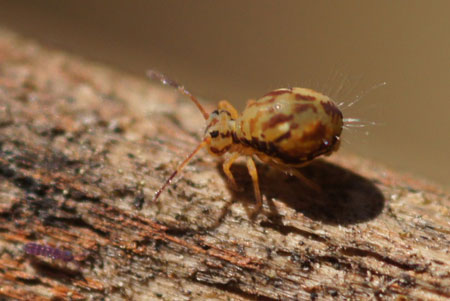 .. ..
 . .
 Dicyrtomina saundersi. Family Dicyrtomidae. Class springtails (Collembola). Dicyrtomina saundersi. Family Dicyrtomidae. Class springtails (Collembola).
Dicyrtomina saundersi is characterised by an antenna in which the colour distinctly changes at the joint of the 2nd to 3rd antennal segment from pale to dark. More pale specimens, the antennae may look 2-coloured. The first part of the antennae of darker spingtails isn't pale but also dark. Look at the photo to the right. At the posterior end of the abdomen it has a spot with a distinctive pattern. (multi-barred cross) The bottom left of the first picture: juvenile Vertagopus arboreus. Photo's 7-3-2011, 3-2-2014.
|
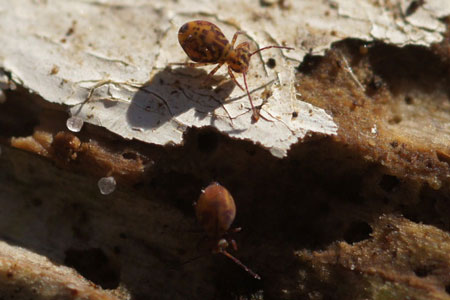 .. ..
 Dicyrtomina
ornata. Family Dicyrtomidae. Class springtails (Collembola). Dicyrtomina
ornata. Family Dicyrtomidae. Class springtails (Collembola).
This springtail is similar to the D. saundersi. But the antennas have one colour. More pale specimens, the antennae may look 2-coloured. At the posterior end of the abdomen it has also a spot. But not with such a distinctive pattern. The lower springtail is a pale Dicyrtoma fusca. Photos 7-3-2011. Photos 7-3-2011. |
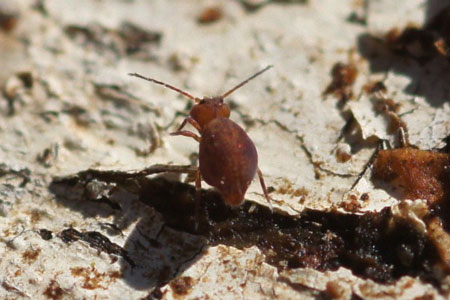 .. ..
 Dicyrtoma
fusca. Family Dicyrtomidae. Class springtails (Collembola). Dicyrtoma
fusca. Family Dicyrtomidae. Class springtails (Collembola).
This spring tail is less marked than the other two Dicyrtoma.. They have a short fourth antenna segment. (A characteristic of Dictyrtoma) Photos 7-3-2011. |
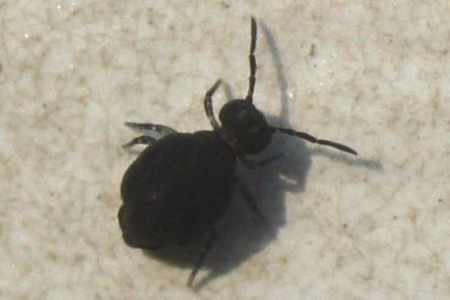 Sminthurinus lawrencei. Family Katiannidae. Class springtails (Collembola).
Sminthurinus lawrencei. Family Katiannidae. Class springtails (Collembola).
Sminthurinus lawrencei is 1.0 mm long and is completely black in colour with a small spot above the eyes. At first I thought of Sminthurinus niger, which also has a white spot near the eyes, which is however larger and more obvious. But identified by Roel van Bezouw as Sminthurinus lawrencei. Photo 1-12-2017. Species in the Netherlands: Sminthurinus albifrons, Sminthurinus alpinus, Sminthurinus aureus, Sminthurinus bimaculatus, Sminthurinus domesticus, Sminthurinus elegans, Sminthurinus henshawi, Sminthurinus igniceps, Sminthurinus lawrencei, Sminthurinus niger, Sminthurinus reticulatus, Sminthurinus trinotatus |
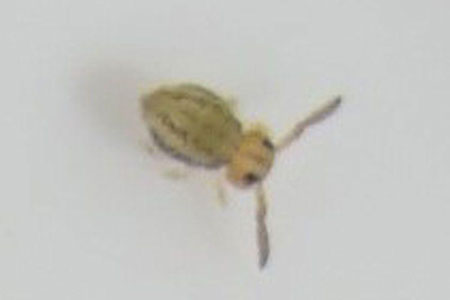 .. ..
 Sminthurinus
. Family Katiannidae. Class springtails (Collembola). Sminthurinus
. Family Katiannidae. Class springtails (Collembola).
Sminthurinus elegans grows to 1.0 mm long. This one was smaller compared to the Drymus of about 4 mm in the photo. I only saw it when I looked at the photo. Sminthurinus elegans has 4 dark longitudinal stripes.
Photo 23-3-2019. |
 .. ..
 Allacma fusca. Family Sminthuridae. Class springtails (Collembola).
Allacma fusca. Family Sminthuridae. Class springtails (Collembola).
After rain you can find many Allacma fusca springtails on tree trunks looking for algae. I see them on my small greenhouse. Then are also algae. Photos 14-8-2012. |
Elongated springtails:
Family
Entomobryidae.
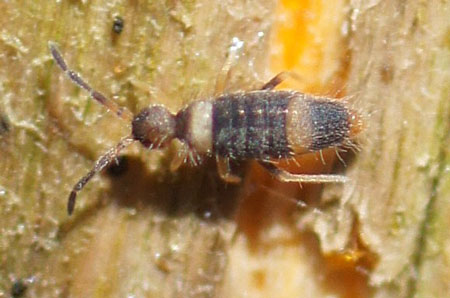 .. ..
 Entomobrya albocincta. Family Entomobryidae. Class springtails (Collembola).
Entomobrya albocincta. Family Entomobryidae. Class springtails (Collembola).
About 2 mm. It has a striking white band at the shoulders. On the abdomen you can see a orange band. The end of the abdomen is also orange. Photos 11-3-2012. |
 .. ..
 Entomobrya
nivalis. Family Entomobryidae. Class springtails (Collembola). Entomobrya
nivalis. Family Entomobryidae. Class springtails (Collembola).
It is usually olive green, but it can also be yellow. The springtail in the picture is about 2 mm. Photos 2-12-2011, 21-3-20112.
|
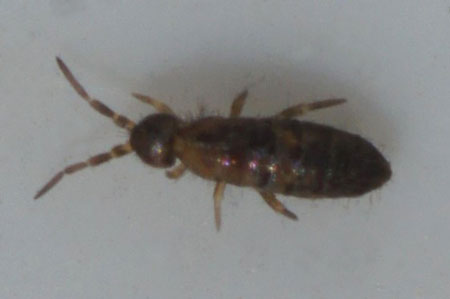 Heteromurus
major. Family Entomobryidae. Class springtails (Collembola). Heteromurus
major. Family Entomobryidae. Class springtails (Collembola).
About 2 mm. Shiny brown with short antenna segments. At the right antenna is missing a segment. Photo 24-2-2017. |
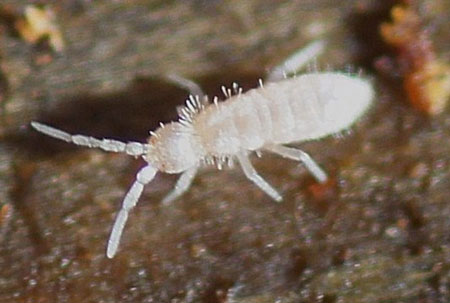 .. ..
 Heteromurus
nitidus. Family Entomobryidae. Class springtails (Collembola). Heteromurus
nitidus. Family Entomobryidae. Class springtails (Collembola).
It looks like an albino. A little lighter because of the reflection of the sunlight. It also has two red eyes. (just be seen if you enlarge the first photo.) It is recognizable by the divided first antennal segment. On the second picture with a young slug. Photos 25-02-2012. |
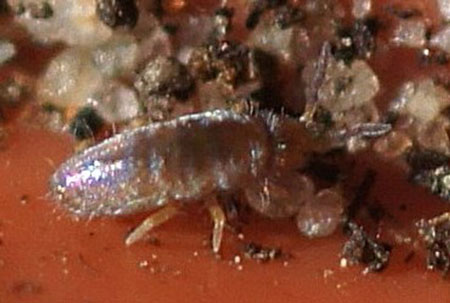 Lepidocyrtus violaceus
or
Lepidocyrtus cyaneus. Family Entomobryidae. Class springtails (Collembola). Lepidocyrtus violaceus
or
Lepidocyrtus cyaneus. Family Entomobryidae. Class springtails (Collembola).
A shiny blue springtail of about 1 - 1,5 mm. Photo 17-2-2014. |
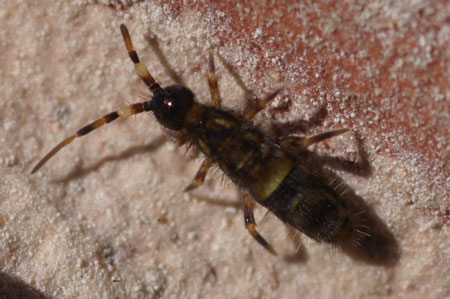 .. ..
 Orchesella
cincta. Family Entomobryidae. Class springtails (Collembola). Orchesella
cincta. Family Entomobryidae. Class springtails (Collembola).
A somewhat larger springtail. This springtail has lost the upper part of the antenna. The other Orchesella cincta is smaller and has less clear marks. Photos 7-3-2011. |
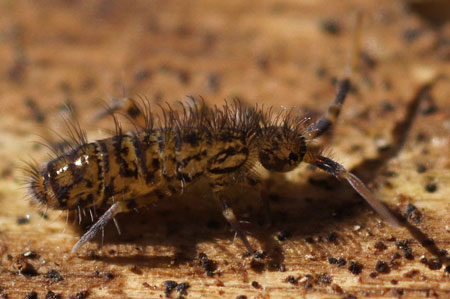 .. ..
 . .
 Orchesella
villosa. Family Entomobryidae. Class springtails (Collembola). Orchesella
villosa. Family Entomobryidae. Class springtails (Collembola).
About 4 mm. With beautiful marks. Photos 20-3-2011, 6-1-20112. |
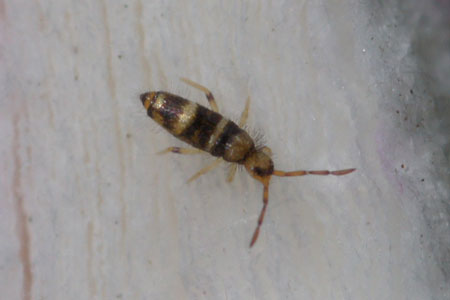 .. ..
 Willowsia platani. Family Entomobryidae. Class springtails (Collembola).
Willowsia platani. Family Entomobryidae. Class springtails (Collembola).
A small springtail. It was walking on the toilet paper. About 3 mm. It was probably on our clothes. It is found in planes. These trees are not near our home. Photos 17-7-2011. |
Family
Isotomidae.
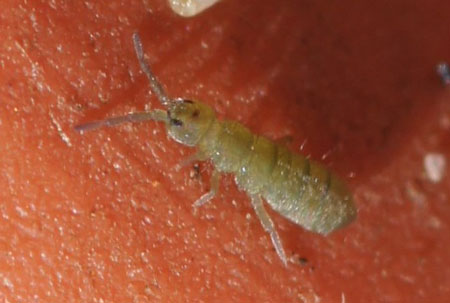 .. ..
 Isotoma viridis. Family Isotomidae. Class springtails (Collembola).
Isotoma viridis. Family Isotomidae. Class springtails (Collembola).
This springtail is remarkably green and looks like, e.g., Isotomurus prasinus, but they are also darker. Isotoma has long hair on all body segments. Not entirely sure, because of all Isotoma species only Isotoma riparia is clearly recognizable from a photograph. The others can only be determined with certainty on the basis of the hair on the jumping mechanism. Photos 16-2-2014. |
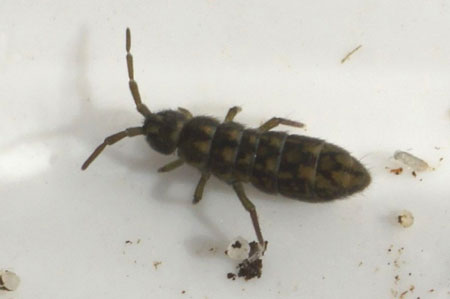 .. ..
 Isotomurus
maculatus. Family Isotomidae. Class springtails (Collembola). Isotomurus
maculatus. Family Isotomidae. Class springtails (Collembola).
The light spots on the back are triangular. This color form is called Isotomurus maculatus f. gervaisi. The regular shape has a dark stripe along the length of the back, which is interrupted on each segment. Photos 30-1-2018.
Photo 2 is a nymph. |
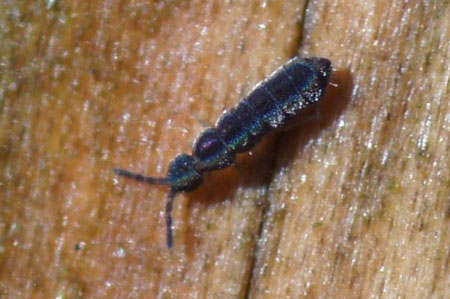 Vertagopus. Family Isotomidae. Class springtails (Collembola).
Vertagopus. Family Isotomidae. Class springtails (Collembola).
There are several Vertagopus species, of which Vertagopus arboreus and Vertagopus cinerea are the most common. The species can only be distinguished by microscopic details. Photo 30-12-2011.
|
Family
Tomoceridae.
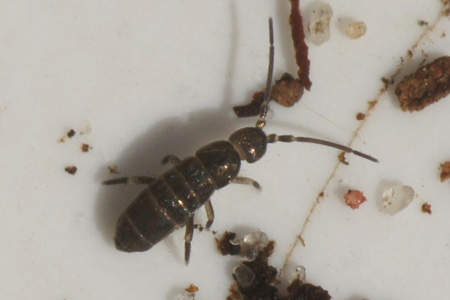 .. ..
 Tomocerus minor. Family Tomoceridae. Class springtails (Collembola). Tomocerus minor. Family Tomoceridae. Class springtails (Collembola).
About 4 mm. It looks like Tomocerus vulgaris. It is a bit lighter and the rings are less noticeable. A small photo with a young springtail. Many scales are missing. Photos 8-2-2018. |
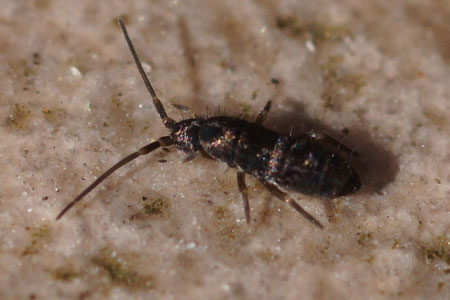 .. ..
 . .
 Tomocerus
vulgaris. Family Tomoceridae. Class springtails (Collembola). Tomocerus
vulgaris. Family Tomoceridae. Class springtails (Collembola).
About 4 mm and very active. Luckily it did just sit still for the picture. Dark and shiny in the sun with shiny rings. Photos 19-3-2011.
On 12-12-2011 I saw a yellow springtail. It was a Tomocerus vulgaris. This springtail had lost its scales. The light yellow colour is under the scales.Photos 19-3-2011, 12-12-2011. |
Nederlands /
Dutch
 
All subpages:
|
